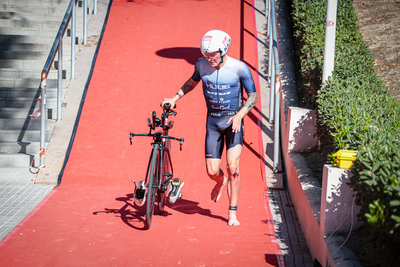Pro British triathlete Tom Bishop is perhaps best known for his prowess over shorter distances after racking up numerous podium finishes during more than 10 years of racing on the ITU circuit.
Renowned for being one of the quickest swimmers around, Tom is making the step up from Sprint and Olympic triathlons to try his hand at middle-distance racing. We caught up with Tom to find out how he’s adapted his approach to training, racing and nutrition for the longer format…
Hi Tom, what advantages from short course racing do you take into middle-distance events?
I think my swimming experience has helped. The swim standard in short course racing is so high and you have to deal with massive congestion at the buoys. Whilst the swimming standard in longer distances is obviously high, it’s easier to get yourself in a good position.
There are also other small skills you get from short course, such as mounting and dismounting your bike in transition quickly, plus bike handling.
What has been the biggest challenge of stepping up to middle-distance racing?
Finding an extra ounce of patience during the race has been one of the biggest challenges for me. In short course you basically have to go 'full gas', but that’s just not possible in middle-distance racing – as I found out when going out too hard at the PTO US Open in Dallas.
My average heart rate for the bike was 185 beats per minute, which is my second threshold heart rate; something I should only really see for one-hour maximal efforts. The final 15 kilometres became a battle for survival and avoiding cramps...
With that in mind, will you make any significant changes to your training plan to account for the increased endurance demands?
My training volume hasn’t changed really; I’ve kept the swimming the same as it’s an advantage for me to be at the front of swims. The frequency of cycling and running sessions has dropped, but the volume has maintained, which means I’m doing bigger solo sessions. I’ve also focused on race pace a bit more which has naturally reduced the intensity of certain sessions.
I won’t really be able to answer this question fully until I’ve done a winter focused solely on non-drafting racing. I’ve basically done a quick-fix training program to get ready for a few long course races this year.
So, what does a 'typical' week of training look like for you at the moment then?
| Day | Sessions |
|---|---|
| Monday | Easy aerobic swim 10km run 90-minute ride Gym work |
| Tuesday | VO₂ or race pace swim Easy jog or spin VO₂ or race specific run |
| Wednesday | Long swim Long ride with first threshold efforts totalling 90 mins Medium-long run |
| Thursday | Threshold swim 10km run Threshold or race pace ride |
| Friday | Strength swim Easy run or ride |
| Saturday | Threshold or race pace run Long ride Easy jog |
| Sunday | Long run with 45 mins at first threshold Long ride |
What have been the biggest changes you've made to your race nutrition strategy for longer events?
My pre-race strategy is basically the same as for short course, so pizza or a rice dish the night before and then eggs on toast for breakfast as part of my carb-load, with a PH 1500 the night before and morning of for preloading my hydration.
In terms of fueling during races, the PTO US Open was a steep learning curve for me. I’d gone into the race with a calf injury, so went hard on the swim and bike, not really knowing if I’d make it through the run.
As it was, I was fine running the 18km and, if I’d have known this in advance, I’d have played the race entirely differently. Hindsight is a cruel mistress. I tore through my nutrition on the bike and was empty getting onto the run, but all I could stomach was water for the final leg. I didn’t have to finish the race but I wanted to respect my wildcard invite and so I forced my way around.
I'll be working on my nutrition for this level of heat and effort!
I think that race and my first few months of training for IM 70.3 events have taught me the importance of carbohydrates! You need to fuel the races but also the big training sessions. I’ve been trying my best to be fueled up for every key session.

Have you picked up any useful tips for how to carry your fuel?
I use a camel back reservoir and stuff it down the front of my suit because the testing I’ve done shows that it’s more aero. I’ve found aero bottles can be good too if they test aerodynamically well.
And what have been the biggest lessons you've learned since switching your focus to longer stuff?
My first three races were far from ideal. At Challenge Fishguard, I got really bad blisters, so I've been looking at my choice of socks.
At IM 70.3 Swansea, I rode a rear flat for the entire ride so I was pretty down finishing the bike, although the tyre inserts saved me slightly. I also lost my gel bottle after 2km, which meant fueling wasn’t great.
The third race at Dallas, I hadn’t run for nearly three weeks going into the race, so I was just happy to complete rather than compete.
Over the winter, I'll take the learnings from my initial 'schooling' in middle and long distance and apply them to next year.